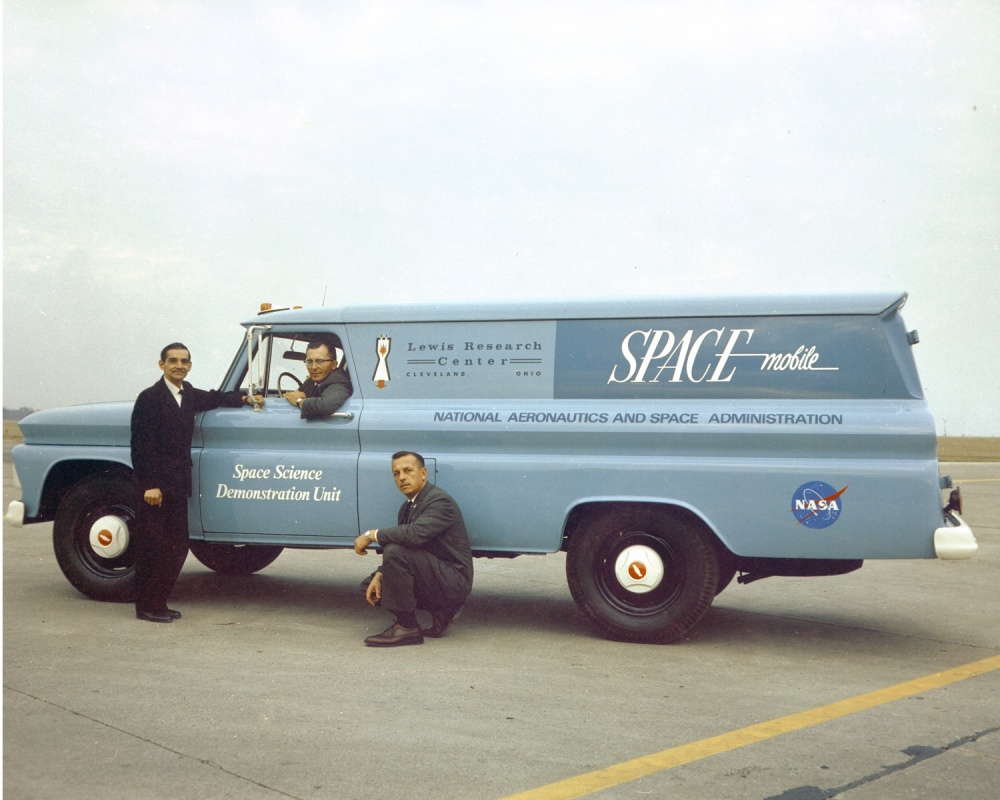
Posted November 29, 2020
By Christina Roberts
In this post I introduce my project about NASA’s Spacemobile program. At the end I identify concepts from Critical Infrastructures Studies that will be useful in my research. My next post will describe Knowledge Infrastructures theory as it relates to my research project.
Spacemobile – Traveling Science Education
The Spacemobile program was born from the popular museum science tradition at the Franklin Institute in Philadelphia, PA in 1961. The Franklin Institute pitched the traveling space science program to NASA, which gave them the inaugural one-year contract. It was so successful that the Franklin Institute decided it could not keep up with the demand. The Spacemobile contract was awarded to several different entities over the years, but was most notably managed for NASA by Oklahoma State University for several decades.
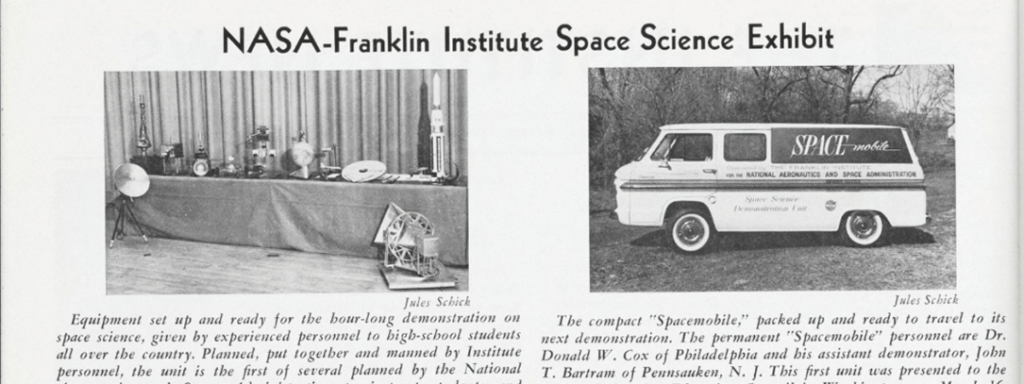
By 1964, NASA’s Educational Programs and Services developed a more formal space science education program that consisted of teacher pre-service and in-service training and numerous curriculum supplements. NASA Centers collaborated with the U.S. Office of Education’s State Science Supervisors and various public universities and state colleges to administer the program. The formal name of the Spacemobile program was Aeronautics Education Services Program (AESP), and it lasted for over fifty years. A link to the AESP archive is found here.
NASA Education – Growing Pains
My project examines NASA’s dual role as science popularizer and educator. The agency’s actions were based on the 1958 Space Act which mandated that NASA “contribute materially to…the expansion of human knowledge of phenomena in the atmosphere and space” and “to provide for the widest practicable and appropriate dissemination of information concerning its activities and the results thereof.” Informing the public also required educating them about space science.
When the agency first opened, it had a Public Information Office that communicated agency activities to the public. NASA administrators soon realized that Public Information and Education needed to separate. The organization charts below show how the dual nature of the agency evolved into separate departments, which potentially subsumed the educational aspect beneath the publicity aspect of of NASA’s mandate. The rapid reorganization of the Education Division encompasses the growth of the Spacemobile program from 2 units in 1961 to dozens of units, each crewed by two educators, during the 1960s.
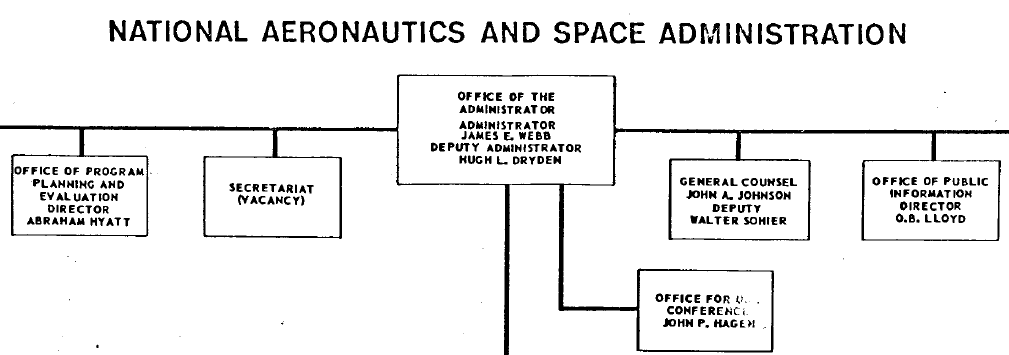
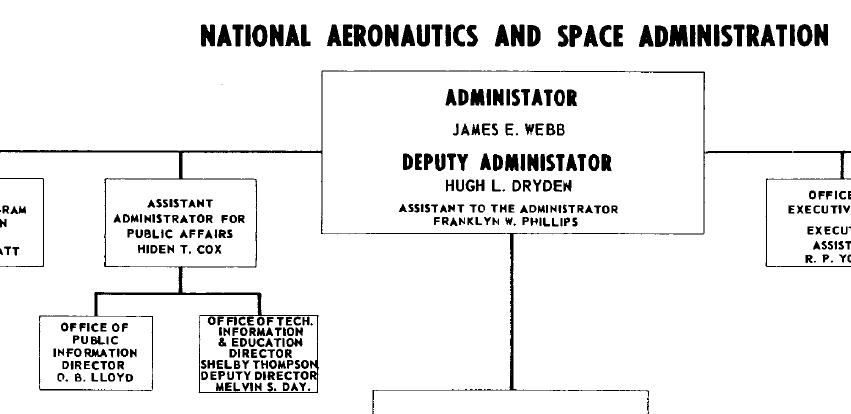
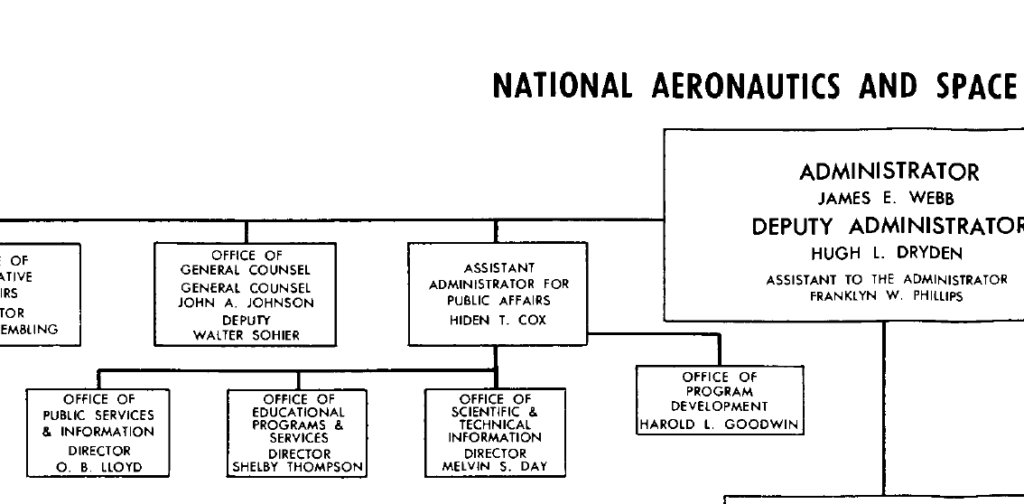
NASA as a Science Educator
The Education Division was staffed by educators, not technicians, entertainers, or actors. Unlike many other contemporaneous popularization efforts on television and radio, NASA required that public education be provided by experienced science educators.
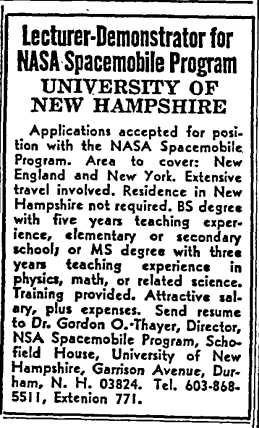
It can be strange to think of NASA as a science educator because for several years the space program was portrayed as glamorous and exciting, a perfect vehicle for space science popularization.
Even the models and props used by the Spacemobile educators represented cutting edge space science and technology that connected attendees directly to the high-tech image of the space age. Considering how entertaining the shows were, it may be difficult for us to view them as educational.

Additionally, the educational content of the program was designed for easy and informal consumption in public spaces, lecture halls, school auditoriums and radio and television shows, and more formally in classrooms. Several of the early Spacemobilers also staffed the World of Science NASA exhibit at the 1962 World’s Fair in Seattle, WA. Below is a photo of the entrance to the U.S. Science Exhibit with a model of the Mariner space probe, launched that summer.
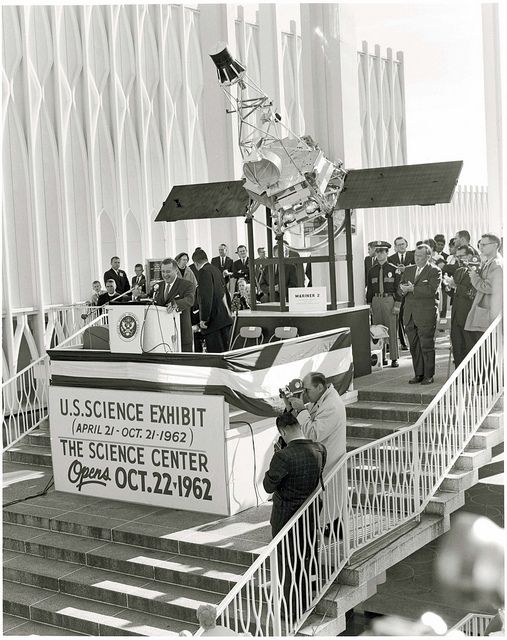
(Image courtesy of the Museum of History and Industry)
In every instance of public education, NASA tried to improve the public understanding of the science utilized to launch rockets and maintain satellites in orbit. NASA educators hoped that children, especially, would be drawn to science at an early age, eagerly partake of science education at all levels of schooling and potentially increase the national stock of scientists available in the employment pipeline. NASA administrators suggested that people who understood science were better equipped as American citizens to make responsible choices and decisions about life in a dynamic and rapidly changing space age.
Traveling Science Educators in the 1950s
NASA was not the first federal agency to take science education to the people. Programs were conducted in the 1950s by the National Science Foundation, the Atomic Energy Commission, and the USAF – Civil Air Patrol.
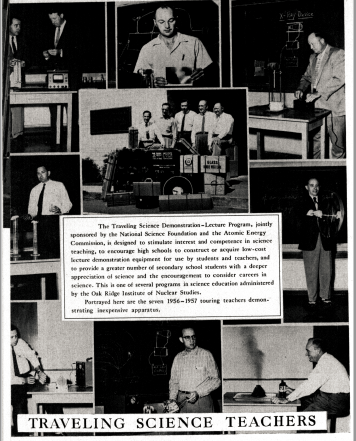
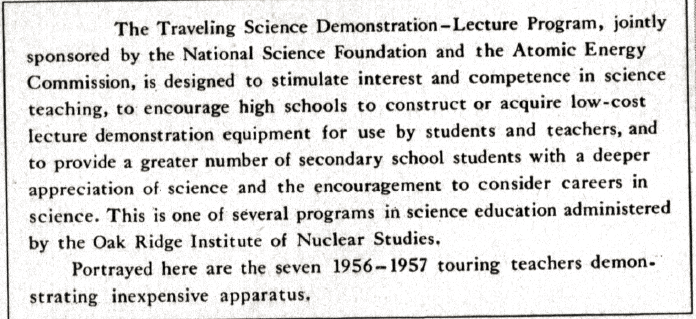
Public Aviation Science Education
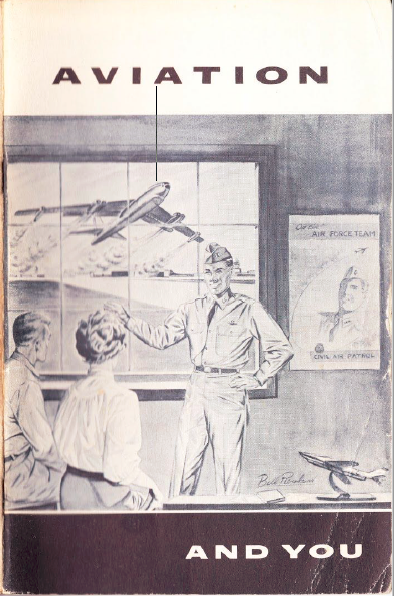
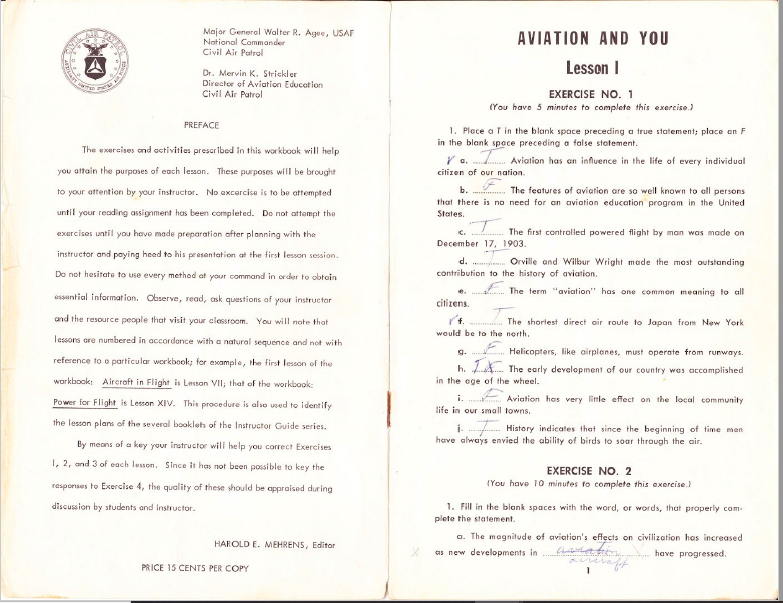
Many of the early Spacemobilers were experienced public science educators who worked for these other programs in the 1950s and also appeared in regional public television and radio educational science programming. They were adept at increasing the public understanding of general, atomic and aeronautic science. Moving their skills and experience over to the NASA Education Division by the 1960s was a good fit. (See the Aerospace Education Services Program Archive “Writings” for examples.)
NASA’s Education Style – Supplement Curriculum and Train Teachers
My research shows that the Spacemobile program was only one of NASA’s tools to introduce space science into the nation’s science education infrastructure. Supplemental educational materials and immersive teacher training were NASA’s forte. The agency did not beat the drum for education reform so much as show educators that they and their curricula had to catch up to the space age. NASA then provided the tools and training to make it happen, such as this handbook of lesson plans from 1963, “Teaching to Meet the Challenges of the Space Age.”
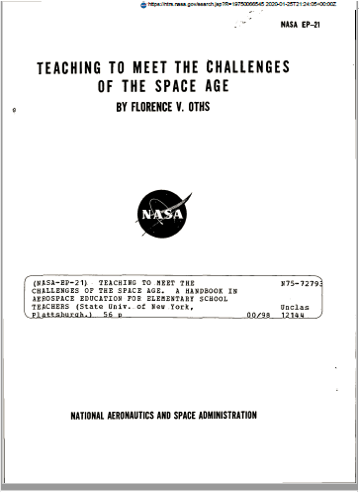
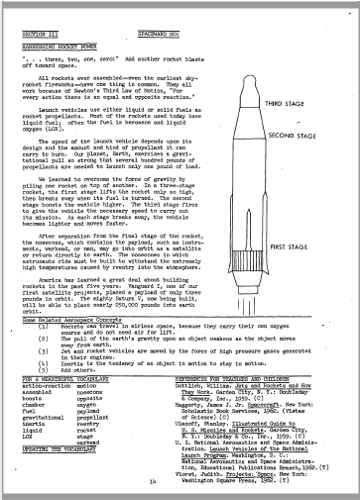
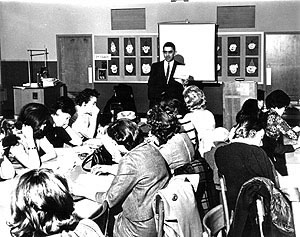
History of General and Science Education
Even though NASA doesn’t present itself as a science education reformer, science curriculum reform was a major trend in the 1950s and 1960s for many reasons. Historians cover the history of social, political, and cultural influences on educational trends of the twentieth century.1 The historians cited here have framed the issues as a federal versus local battle over reform; they have emphasized periods of significant educational change after Word War II when scientists tried to take charge of science education, after the Soviet Sputnik shock, during the Civil Rights era, and as a result of the expansion of federal education funding during the Cold War.
Historians have studied NASA’s Public Affairs, but haven’t paid much attention to how NASA’s space popularization manifested in the nation’s science curriculum. Like other twentieth-century science popularizers, NASA tried to improve public science understanding and increase the scientific workforce for their own purposes. NASA also professed contemporary views about science and citizenship and the role of scientific and technological expertise in national life. To date, my research is based on digitized primary sources that include conference proceedings, speeches, newsletters, educator memoirs and papers, lesson plans, and educator resources. My contribution will construct a historical narrative about NASA’s role as not only a science popularizer, but as a science educator.
Where Knowledge Infrastructures Come In
An obstacle to research in education history is the decentralized nature of the American education system itself, because states have historically determined their own education systems. The federal government was largely hands-off until the 1955 Brown V Board of Education decision in 1955 and the 1958 National Defense Education Act. NASA’s instinct to enlist the State Education Officers was potentially quite innovative. NASA probably also took advantage of schools being more receptive to federal involvement through increased spending on all things science, a historically relevant trend during the Cold War.
In addition to the NASA/State school system dynamic, many other interested parties were involved such as educators, scientists, parents and children. Then there were networks of professional educator organizations, federal science agencies, and popular and public science boosters who all wanted to improve science education. Thus, the historic picture is much more complicated than the Spacemobile program initially signifies.
This is where the definition of Knowledge Infrastructures (KIs) becomes helpful. I take my cues from a workshop conference report from 2012, “Knowledge Infrastructures: Intellectual Frameworks and Research Challenges.” KIs are robust networks of people, artifacts, and institutions that generate, share, and maintain specific knowledge about the human and natural worlds. KIs include individuals, organizations, routines, shared norms and practices.
For now, I leave the reader to ponder the definition of Knowledge Infrastructures. I will return to excavate the KIs involved in NASA science education, and explain the relevance of other concepts from Critical Infrastructure Studies such as “the stack” and “co-production” and sociological theory about public demonstrations.
References
1Five commendable books about the period include American Education, A History by Urban, Wagoner, and Gaither (2019), Scientists in the Classroom: The Cold War Reconstruction of American Science Education by John L. Rudolph (2002), More Than Science and Sputnik: The National Defense Education Act of 1958 by Wayne J. Urban (2010), Cities of Knowledge: Cold War Science and the Search for the Next Silicon Valley by Margaret Pugh O’Mara (2005), and finally Building the Federal Schoolhouse: Localism and the American Education State by Douglas S. Reed (2014).
“Aerospace Education Texts And Workbooks, 1956-1958 · Civil Air Patrol National History Program”. 2020. History.Cap.Gov. https://history.cap.gov/document/180.
“”Atoms For Peace” Mobile Exhibits”. 2020. COLD WAR: L.A.. http://www.coldwarla.com/atoms-for-peace-mobile-exibits.html.
Edwards, Paul N., Steven J. Jackson, Melissa K. Chalmers, Geoffrey C. Bowker, Christine L. Borgman, David Ribes, Matt Burton, and Scout Calvert. 2013. “Knowledge Infrastructures: Intellectual Frameworks And Research Challenges”. Deepblue.Lib.Umich.Edu. https://deepblue.lib.umich.edu/handle/20
Messer, Todd, and Steve Garber, and SA 10.08.04. 2020. “NASA Organizational Charts”. History.Nasa.Gov. https://history.nasa.gov/orgcharts/orgcharts.html#1958.
Museum of History and Industry. “NASA Exhibit, Seattle World’s Fair, 1962”. 2020. Digitalcollections.Lib.Washington.Edu. https://digitalcollections.lib.washington.edu
NASA Space Act of 1958. “National Aeronautics And Space Act Of 1958 (Unamended) “. 2020. History.Nasa.Gov. https://history.nasa.gov/spaceact.html.
“National Science Foundation FY 1957 Annual Report”. 2020. Nsf.Gov. https://www.nsf.gov/pubs/1957/annualrep
“OSU/NASA Education Projects: Aerospace Education Services Program (AESP) Archive”. 2020. Nasaweb.Nasa.Okstate.Edu. http://nasaweb.nasa.okstate.edu/index.htm